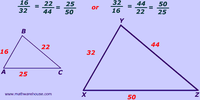Hi. I've been stuck on this question forever (5bii). 
Because the pair of triangles are similar, as proven in part A, this means that their sides are proportionate to each other. I gather that I am supposed to compare the ratios of side lengths by using fractions to solve an equation as shown in this example:

But I am confused for two reasons: Firstly, the smaller triangle is positioned differently to the bigger triangle.. they are facing different directions. Secondly, I don't think I have enough information for side lengths to make an equation with only one unknown variable.
Any help appreciated
Thanks so much.
Because the pair of triangles are similar, as proven in part A, this means that their sides are proportionate to each other. I gather that I am supposed to compare the ratios of side lengths by using fractions to solve an equation as shown in this example:

But I am confused for two reasons: Firstly, the smaller triangle is positioned differently to the bigger triangle.. they are facing different directions. Secondly, I don't think I have enough information for side lengths to make an equation with only one unknown variable.
Any help appreciated
Thanks so much.
